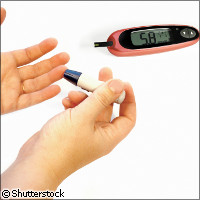EU study warns type 1 diabetes in children to double by 2020
Type 1 diabetes will continue to rear its ugly head in Europe as the number of cases in children under five years of age will double by 2020, new EU-funded research shows. The findings, published online in The Lancet journal, also indicate that children older than five will not escape unscathed from this trend. The results are part of the EURODIAB ('Epidemiology, aetiology and public health aspects of diabetes mellitus') Study Group, a collaboration supported in part by the EU's Framework Programmes. 'The emergence of type 2 diabetes in children and adolescents has received much attention, but this issue should not be allowed to overshadow the rapid rise in type 1 diabetes in this age group,' the authors of the study write. 'Although in a few countries most cases in children will be type 2 diabetes, in most European countries type 1 is, and will probably remain, the predominant form of this disease.' Current data indicates that while type 1 diabetes represents 1 out of 10 general diabetes cases, children with type 1 outnumber those diagnosed with type 2 diabetes. Type 1 diabetes is triggered by insulin deficiency, forcing sufferers to inject themselves daily with insulin for treatment. For this study, the researchers evaluated diabetes data from 20 centres in 17 EU Member States. From 1989 to 2003, the Member States registered 29,311 cases of type 1 diabetes. According to the researchers, the overall increase in the incidence of type 1 diabetes was almost 4% each year. A breakdown shows that the year-on-year increase was 5.4% for the age group from 0 to 4 years, 4.3% for the age group from 5 to 9 years, and 2.9% for those aged between 10 and 14. Also, the researchers estimated that some 15,000 new cases emerged in Europe in 2005: 24% for the age group between 0 and 4 years; 37% for those aged between 5 and 9 years; and 34% for those between the ages of 10 and 14. By 2020, the number of new cases will probably reach 24,400, with the youngest age group suffering a twofold increase, and a more even distribution across age groups (0 to 4 years, 29%; 5 to 9 years, 37%; and 10 to 14 years, 34%, respectively). According to the researchers, Europe will record a whopping 70% rise in the number of children under the age of 15 with type 1 diabetes (from 94,000 to 160,000). 'The predicted rise in childhood type 1 diabetes in Europe during the next 20 years, and the raised proportion of cases diagnosed at younger ages than were before, could result in more cases presenting with ketoacidosis [a life-threatening complication brought on by the near-complete deficiency of insulin and elevated levels of certain stress hormones] and needing hospital admission,' the authors warn. The researchers noted how European countries 'need to ensure appropriate planning of services and that resources are in place to provide high-quality care for the increased numbers of children who will be diagnosed with diabetes in future years'. Despite the accelerated changes witnessed over the years, the researchers do not believe genetic factors are solely responsible for this growing trend. 'Several hypotheses, based on analytical epidemiological studies, have pointed to modern lifestyle habits as possible environmental factors, such as increased weight and height development, and caesarean section deliveries, or reduced frequency of early infections,' the authors explain. 'This notion accords with reported ecological associations between estimates of gross domestic product (GDP) and incidence rate in European countries. Faster rates of increase in countries with low incidence rate - in particular eastern European countries - might be an expression of effects of lifestyle factors, which are changing rapidly in these countries.' In a nutshell, convergence of incidence rates could reflect harmonisation of lifestyle-related risk factors in Europe, they said. Research centres participating in this study included Charles University in the Czech Republic, University Children's Hospital at Tuebingen in Germany, the Medical University of Vienna in Austria, the Institute of Diabetes and Metabolic Diseases in Romania, and the University of Leeds in the UK.



